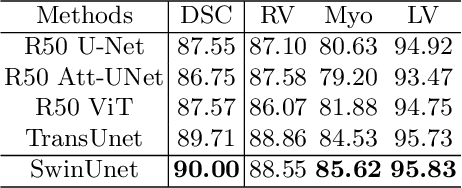Yueyue Wang
Swin-Unet: Unet-like Pure Transformer for Medical Image Segmentation
May 12, 2021



Abstract:In the past few years, convolutional neural networks (CNNs) have achieved milestones in medical image analysis. Especially, the deep neural networks based on U-shaped architecture and skip-connections have been widely applied in a variety of medical image tasks. However, although CNN has achieved excellent performance, it cannot learn global and long-range semantic information interaction well due to the locality of the convolution operation. In this paper, we propose Swin-Unet, which is an Unet-like pure Transformer for medical image segmentation. The tokenized image patches are fed into the Transformer-based U-shaped Encoder-Decoder architecture with skip-connections for local-global semantic feature learning. Specifically, we use hierarchical Swin Transformer with shifted windows as the encoder to extract context features. And a symmetric Swin Transformer-based decoder with patch expanding layer is designed to perform the up-sampling operation to restore the spatial resolution of the feature maps. Under the direct down-sampling and up-sampling of the inputs and outputs by 4x, experiments on multi-organ and cardiac segmentation tasks demonstrate that the pure Transformer-based U-shaped Encoder-Decoder network outperforms those methods with full-convolution or the combination of transformer and convolution. The codes and trained models will be publicly available at https://github.com/HuCaoFighting/Swin-Unet.
Organ at Risk Segmentation in Head and Neck CT Images by Using a Two-Stage Segmentation Framework Based on 3D U-Net
Aug 25, 2018



Abstract:Accurate segmentation of organ at risk (OAR) play a critical role in the treatment planning of image guided radiation treatment of head and neck cancer. This segmentation task is challenging for both human and automatic algorithms because of the relatively large number of OARs to be segmented, the large variability of the size and morphology across different OARs, and the low contrast of between some OARs and the background. In this paper, we proposed a two-stage segmentation framework based on 3D U-Net. In this framework, the segmentation of each OAR is decomposed into two sub-tasks: locating a bounding box of the OAR and segment it from a small volume within the bounding box, and each sub-tasks is fulfilled by a dedicated 3D U-Net. The decomposition makes each of the two sub-tasks much easier, so that they can be better completed. We evaluated the proposed method and compared it to state-of-the-art methods by using the MICCAI 2015 Challenge dataset. In terms of the boundary-based metric 95HD, the proposed method ranked first in eight of all nine OARs and ranked second in the other OAR. In terms of the area-based metric DSC, the proposed method ranked first in six of the nine OARs and ranked second in the other three OARs with small difference with the first one.
 Add to Chrome
Add to Chrome Add to Firefox
Add to Firefox Add to Edge
Add to Edge